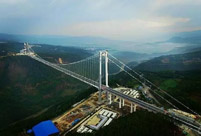

US MILITARY BASES: In fact China has been surrounded by US military bases in Alaska, Hawaii and Guam in the Pacific and much closer to China with the bases in Japan (Okinawa), Korea, the Philippines, Thailand and Australia. The USA can also draw on from military bases in the British Indian Ocean Territories. As Chalmers Johnson points out that all foreign military bases are designed for offence. There is no sign of the US to loosen the noose it set up for China; now attempts are afoot to tighten it further. The encircling of Chine is so comprehensive that it can mean one thing - choke China.
While the people in Okinawa demonstrated vigorously against the presence of US military bases there, the US occupation of Okinawa has been going on for a long time since the occupation of Japan in 1945. Again, according to Chalmers Johnson, military bases are the American version of colonies. A regime change was carried out quietly in Japan when the then Japanese Prime Minister Hatoyama dared to show some sympathy for the demonstrators; in comes Shinzo Abe who is not only striving hard to militarise Japan (which now the USA fully endorses but seriously upsets its another close ally, South Korea) but also to double the size of the armed forces without any constitutional constraints (may be, to serve as a mercenary force for the USA). Japan fully backed a statement released by the G-7 summit held in the atom-bombed city of Hiroshima very recently (April, 2016) asking China to refrain from taking "unilateral actions". China pointed out that Japan had hijacked the platform (G-7 Summit) in an attempt to contain China. China further alleged that the statement was the result of Japan's consistent efforts to hype up the South China Sea issue, despite none of the G-7 countries are party to the dispute.
As for China, it obviously refuses to accept the status quo based on the US hegemony. The South China Sea for China is a "core issue'' at par with Taiwan. This sea route is vital for China's economic engagement with the rest of the world. China accuses the USA inflating the issue in the South China Sea to tip geopolitical power in its favour, even accusing the USA of deliberately provoking China to react. The South China Sea is now teeming with US warships with cutting edge offensive weapons, missile destroyers and strategic bombers thus militarising the sea while accusing China for doing the same. But China sees its acts as an act of self-defence; and definitely China was not the first country to deploy weapons or conduct military manoeuvres in the region, rather China just responded to when the USA sent armed naval vessels to the sea. For China it was just a case of self-preservation.
US ADMIRAL VISITS NEW DELHI: Admiral Harry Harris visited New Delhi in the very beginning of March this year and urged India to align closely with the USA in a security dialogue, military exercises and armament purchase (India now stands as the second largest armament buyer from the USA only after Saudi Arabia). This emphasis on security as a strategy underlines the real US motive - it conveys insecurity in the region. Then what is the source of this insecurity? From the US perspective it is clear - China. This is to take advantage of the current strained relationship between China and its neighbours to maintain its hegemony by convincing many of these countries that they still need the USA to underwrite their security. To "pivot" to Asia is consistent with that strategy with the emphasis on security and therefore to militarise the Pacific region. The USA's strong presence in the Asia-Pacific Region is nothing new, it all have started with the colonisation of the Philippines in 1898 and Korea and Vietnam wars happened in our life time. The current phase of pivoting to Asia is a code word for more aggressive form of militarisation to stop China to rise peacefully. To achieve that, foster as much and as many alliances as possible and India should also be a part of that strategy.
The Admiral also canvassed for a quadrilateral security dialogue involving the US, Japan, Australia and India with the aim to pose a collective challenge to China in the South China Sea. India's previous government rejected such an idea but the US now is getting a positive vive from the current government which would likely bring these two military establishments closer. India, meanwhile, is getting increasingly involved in the South China Sea through its oil exploration agreement with Vietnam and to enforce "freedom of navigation operations" in the South China Sea (as if China has blocked it anyway; to do so will harm China more than any other countries). It has also established a satellite tracking centre in the South of Vietnam. What India needs to understand is that helping the USA to maintain its dominant position in the face of rising Chinese power will only lead to instability in Asia. Now it appears that the bilateral military relations have progressed further where both the USA and India have agreed in principle to share logistics, a code word for allowing the USA to establish military bases in India, to counter the growing maritime assertiveness of China in the Indian Ocean and the South China Sea.
 |  |
 French girl ties the knot with Chinese boy
French girl ties the knot with Chinese boy Beijing Style: ready for bare legs
Beijing Style: ready for bare legs Century-old station sees railyway evolution
Century-old station sees railyway evolution Enthusiasts perform Kung Fu at Wudang Mountain
Enthusiasts perform Kung Fu at Wudang Mountain Stunning photos of China's fighter jets in drill
Stunning photos of China's fighter jets in drill Monk's mummified body to be made into a gold Buddha statue
Monk's mummified body to be made into a gold Buddha statue Former Chinese solider of the French Foreign Legion seeks wife online
Former Chinese solider of the French Foreign Legion seeks wife online Asia's longest and highest suspension bridge to open to traffic
Asia's longest and highest suspension bridge to open to traffic China's first interactive robot looks like a beauty
China's first interactive robot looks like a beauty Top 20 hottest women in the world in 2014
Top 20 hottest women in the world in 2014 Top 10 hardest languages to learn
Top 10 hardest languages to learn 10 Chinese female stars with most beautiful faces
10 Chinese female stars with most beautiful faces China’s Top 10 Unique Bridges, Highways and Roads
China’s Top 10 Unique Bridges, Highways and Roads Can US win a new Cold War upon China?
Can US win a new Cold War upon China? China sitting on data goldmine
China sitting on data goldmine Experts say Sino-US space collaboration is likely to stay sci-fi
Experts say Sino-US space collaboration is likely to stay sci-fi Chinese NGOs receive less from overseas backers as new law stresses national security
Chinese NGOs receive less from overseas backers as new law stresses national securityDay|Week